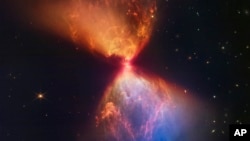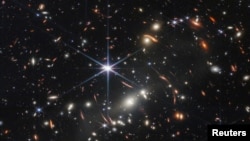The James Webb Space Telescope recently celebrated its first year in operation. During that time, the orbiting observatory – operated by the American space agency NASA – produced colorful, detailed images. It has also helped researchers make several new scientific discoveries.
NASA has described the telescope as the largest, most powerful telescope ever sent into space. The agency launched the Webb in late 2021 and released its first images in July 2022.
The Webb’s first full-color images were presented by President Joe Biden. One of the images showed the clearest picture yet of the early universe, about 13 billion years ago.
NASA Administrator Bill Nelson marked the anniversary with a statement. He said, "In just one year, the James Webb Space Telescope has transformed humanity's view of the cosmos, peering into dust clouds and seeing light from faraway corners of the universe for the very first time."
Most recently, NASA celebrated the Webb’s one year anniversary by releasing one of its latest images. The image showed a cloud collection of 50 stars in the process of forming. NASA said the image showed an area of space that is full of hydrogen gas and dust. Scientists said the image was a good representation of this brief period in a star’s life.
At around the same time, researchers announced they had used data from the Webb to identify the most distant, active supermassive black hole ever observed. Scientists say the black hole sits in a galaxy called CEERS 1019. The galaxy is thought to have existed about 570 million years after the Big Bang – the explosion many scientists believe created the universe.
The black hole discovery and others that received help from the Webb were in part made possible through the telescope’s infrared instruments. The instruments collect infrared waves passing through gas and dust that can hide objects in space. The infrared system also shows light from more distant parts of the universe.
The Webb’s instruments have also confirmed the distances of some of the farthest galaxies ever observed, NASA reported. In addition, the telescope’s data has provided more detailed information than ever before about the makeup of planet atmospheres. And the instruments have also led to discoveries about the chemicals and gases that exist around collections of stars and exoplanets outside of our solar system.
For example, the Webb helped astronomers observe the most distant molecules known to exist in the universe and also led to the discovery of 12 new moons orbiting Jupiter
In a statement marking the Webb’s one year anniversary, NASA noted the telescope had “resulted in hundreds of scientific papers answering longstanding questions and raising new ones.”
Eric Smith is a Webb program scientist and associate director for research in the Astrophysics Division at NASA Headquarters in Washington. He said the Webb’s wide abilities to support new science discoveries has already become clear. “Webb’s first year of science has not only taught us new things about our universe – but it has revealed the capabilities of the telescope to be greater than our expectations – meaning future discoveries will be even more amazing,” Smith said.
NASA has said the Webb has enough fuel to operate for at least 20 years. It will soon be joined in orbit by Europe's Euclid space telescope, which launched on July 1. Euclid’s main goal, or mission, is to collect data on two of the universe's greatest mysteries: dark energy and dark matter.
I’m Bryan Lynn.
Bryan Lynn wrote this story for VOA Learning English, based on reports from NASA, The Associated Press and Agence France-Presse.
_________________________________________
Words in This Story
transformed–adj. changed into something new or very different
cosmos – n. the whole universe
peer – v. to look through
supermassive – adj. used to describe something that has an extremely large mass
reveal – v. to provide information that is surprising or that was previously secret
What do you think of this story? We want to hear from you. We have a new comment system. Here is how it works:
- Write your comment in the box.
- Under the box, you can see four images for social media accounts. They are for Disqus, Facebook, Twitter and Google.
- Click on one image and a box appears. Enter the login for your social media account. Or you may create one on the Disqus system. It is the blue circle with “D” on it. It is free.
Each time you return to comment on the Learning English site, you can use your account and see your comments and replies to them. Our comment policy is here.














Forum